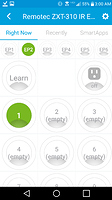I won’t be converting this DTH into an Edge Driver so it will stop working once the Groovy platform is retired.
This is a device handler for the Remotec Z-Wave-to-AV IR Extender (Model: ZXT-310).
General Information
-
The device handler provides 6 sets of 9 buttons which allows you to learn up to 54 IR Codes from other remote controls.
-
Each set of buttons can be configured to use the internal IR Port or any of the External Ports. The device has 5 external ports and comes with 3 - 6’ external cables.
-
You can specify triggers for the 9 buttons. The options are Switch On, Switch Off, Switch On/Off, and Momentary Switch Push.
-
You can also push the buttons using any SmartApp that supports the Switch Level capability. Level 10% pushes button 1, 20% pushes button 2, etc.
-
The triggers and switch levels push the buttons for the active set of buttons, but to switch between the sets of buttons you need to tap the E1-E6 tiles or use a SmartApp like CoRE to execute the custom commands setActiveEP1 - setActiveEP6. Or use the optional SmartApp which will generate a separate virtual device for each set of buttons.
-
All you have to do to program a button is tap the “Learn” tile, tap the button you want to program, hold down the key on the remote control until the LED flashes twice, and then tap the “Learn” tile again.
Code Learning Process
Main Settings
Optional SmartApp and Virtual Devices
The optional SmartApp and device handler provide a lot of additional functionality:
-
The SmartApp creates 6 virtual devices and keeps them in sync with the main device.
-
Each virtual device has 9 buttons with settings for:
- Triggers previously mentioned.
- Button Label
- Button Delay (When using triggers to push multiple buttons, you can use delays to ensure they’re pushed in the right sequence)
- Button Repeat (For buttons like volume up/down, you can use the repeat setting to change the volume by more than one every time the button is pushed.)
- All buttons have to be programmed from the main device. Set the EP# in the main device to the EP# shown in the top center tile of the virtual device. The port setting for each EP # also has to be changed from the main device.










